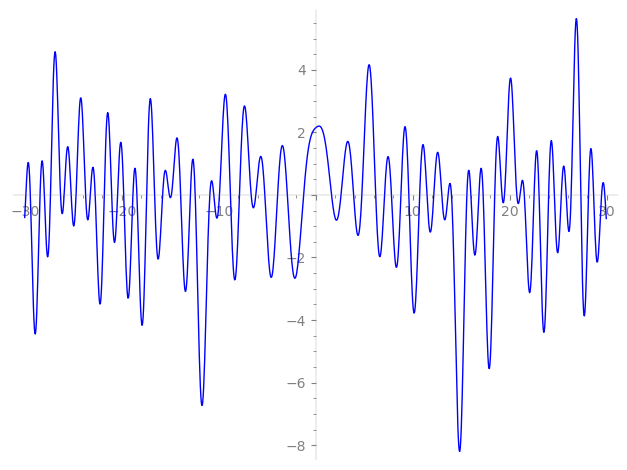| L(s) = 1 | + (0.302 + 0.523i)2-s + (0.354 + 0.614i)3-s + (0.817 − 1.41i)4-s + (0.5 + 0.866i)5-s + (−0.214 + 0.371i)6-s − 7-s + 2.19·8-s + (1.24 − 2.16i)9-s + (−0.302 + 0.523i)10-s − 0.340·11-s + 1.15·12-s + (3.17 − 5.49i)13-s + (−0.302 − 0.523i)14-s + (−0.354 + 0.614i)15-s + (−0.969 − 1.67i)16-s + (2.54 + 4.41i)17-s + ⋯ |
| L(s) = 1 | + (0.213 + 0.370i)2-s + (0.204 + 0.354i)3-s + (0.408 − 0.707i)4-s + (0.223 + 0.387i)5-s + (−0.0875 + 0.151i)6-s − 0.377·7-s + 0.777·8-s + (0.416 − 0.720i)9-s + (−0.0956 + 0.165i)10-s − 0.102·11-s + 0.334·12-s + (0.879 − 1.52i)13-s + (−0.0808 − 0.139i)14-s + (−0.0915 + 0.158i)15-s + (−0.242 − 0.419i)16-s + (0.618 + 1.07i)17-s + ⋯ |
Λ(s)=(=(665s/2ΓC(s)L(s)(0.999−0.0375i)Λ(2−s)
Λ(s)=(=(665s/2ΓC(s+1/2)L(s)(0.999−0.0375i)Λ(1−s)
| Degree: |
2 |
| Conductor: |
665
= 5⋅7⋅19
|
| Sign: |
0.999−0.0375i
|
| Analytic conductor: |
5.31005 |
| Root analytic conductor: |
2.30435 |
| Motivic weight: |
1 |
| Rational: |
no |
| Arithmetic: |
yes |
| Character: |
χ665(596,⋅)
|
| Primitive: |
yes
|
| Self-dual: |
no
|
| Analytic rank: |
0
|
| Selberg data: |
(2, 665, ( :1/2), 0.999−0.0375i)
|
Particular Values
| L(1) |
≈ |
2.14762+0.0403443i |
| L(21) |
≈ |
2.14762+0.0403443i |
| L(23) |
|
not available |
| L(1) |
|
not available |
L(s)=p∏Fp(p−s)−1 | p | Fp(T) |
|---|
| bad | 5 | 1+(−0.5−0.866i)T |
| 7 | 1+T |
| 19 | 1+(4.22−1.08i)T |
| good | 2 | 1+(−0.302−0.523i)T+(−1+1.73i)T2 |
| 3 | 1+(−0.354−0.614i)T+(−1.5+2.59i)T2 |
| 11 | 1+0.340T+11T2 |
| 13 | 1+(−3.17+5.49i)T+(−6.5−11.2i)T2 |
| 17 | 1+(−2.54−4.41i)T+(−8.5+14.7i)T2 |
| 23 | 1+(−2.28+3.95i)T+(−11.5−19.9i)T2 |
| 29 | 1+(4.46−7.73i)T+(−14.5−25.1i)T2 |
| 31 | 1−6.98T+31T2 |
| 37 | 1+5.09T+37T2 |
| 41 | 1+(−5.15−8.92i)T+(−20.5+35.5i)T2 |
| 43 | 1+(1.54+2.67i)T+(−21.5+37.2i)T2 |
| 47 | 1+(−3.43+5.94i)T+(−23.5−40.7i)T2 |
| 53 | 1+(3.62−6.28i)T+(−26.5−45.8i)T2 |
| 59 | 1+(6.28+10.8i)T+(−29.5+51.0i)T2 |
| 61 | 1+(4.62−8.00i)T+(−30.5−52.8i)T2 |
| 67 | 1+(−1.37+2.38i)T+(−33.5−58.0i)T2 |
| 71 | 1+(−1.65−2.86i)T+(−35.5+61.4i)T2 |
| 73 | 1+(−4.01−6.94i)T+(−36.5+63.2i)T2 |
| 79 | 1+(1.89+3.28i)T+(−39.5+68.4i)T2 |
| 83 | 1−2.93T+83T2 |
| 89 | 1+(8.59−14.8i)T+(−44.5−77.0i)T2 |
| 97 | 1+(−1.81−3.14i)T+(−48.5+84.0i)T2 |
| show more | |
| show less | |
L(s)=p∏ j=1∏2(1−αj,pp−s)−1
Imaginary part of the first few zeros on the critical line
−10.50600121850357771497726585850, −9.922391225117823905525177631498, −8.797610185222131381213749753046, −7.86270833804282339900361019643, −6.65351560420198975556681616470, −6.17603827827216047495803920902, −5.24652873657744941649466390605, −3.92929924419163782390043988092, −2.92389515730358385652827210690, −1.25235284977949843713114010027,
1.63181214127192164033378758206, 2.60899021746538729959700511927, 3.90572955083752318576605638144, 4.75482397172763060754111902012, 6.18239824084027760009457030798, 7.09344646910155609624498347766, 7.80816211374419249522723350421, 8.780856771309166145527580194621, 9.599423428870587885710224796719, 10.71254161288893698242392280649

